|
|
|
|
|
|
|
 |
|
 |
|
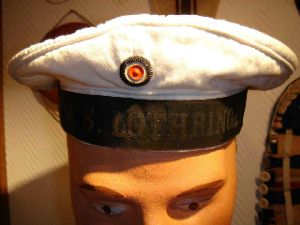 |
|
A blue winter other ranks naval cap ("Mütze") from
the SMS Königsberg (note that the cap tally spells the ship's name in
the alternative way with an "E" after the "O" to replace the umlaut). |
|
A closer look inside the SMS Königsberg cap
showing the owner's name tag. |
|
A white summer cap from the SMS
Lotheringen. |
 |
|
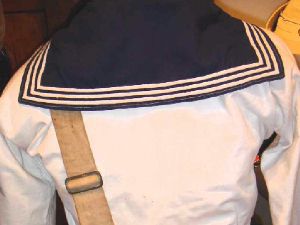 |
|
 |
The uniform of a sailor of the SMS Lotheringen
(the German name for the province of Lorraine, now in France) in landing
gear ("Landungsnzug").
He wears the standard white cotton summer shirt ("Weißes
Hemd")
with the blue naval collar ("Exerzierkragen"
or often familiarly called a "Kieler Kragen" after the port
of Kiel) sewn onto
it.
|
|
The rear of the sailor of the SMS
Lotheringen in landing gear. The bread bag seen here is dated 1887.
|
|
Another close up of
the sailor of the SMS
Lotheringen in Landing gear. This time showing the 1895 model belt
buckle worn by naval and colonial other ranks attached to a pair of
M1871 blackened leather ammunition pouches.
While most colonial troops had brown leather equipment, most naval
troops (except the III. Seebatallion) had blackened leather. |
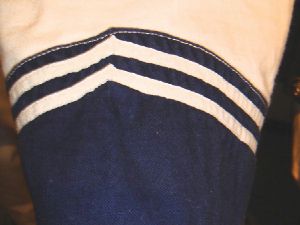 |
|
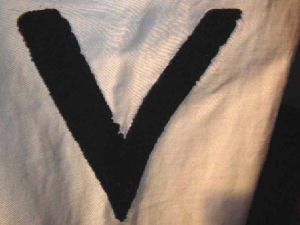 |
|
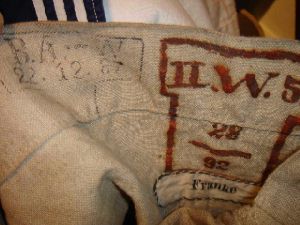 |
|
Details of the cuff of the sailor of the SMS Lotheringen. |
|
Detail of the rank chevron worn by the
sailor of the SMS Lotheringen. The single sewn on navy blue stripe
identifies him as an Obermatrose. |
|
Issue stamp inside the
sailor of the SMS Lotheringen's uniform showing it was issued in
Wilhelmshaven (BAW for "Bekleidung Amt Wilhelmshavn") on 22nd
December 1887. |
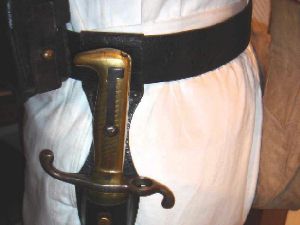 |
|
 |
|
 |
|
Another close up of the sailor of the SMS Lotheringen in Landing gear.
This time showing his M1871 model and ammunition pouches. Although
much of this equipment was obsolete by regular army standards it was
still sometimes issued to naval and colonial forces in 1914. |
|
Another example of the white cotton shirt
with naval collar. This one was originally worn by Robert Barsch of
the SMS Iltis serving in China.
Photo kindly shared with us by his
nephew, Axel Scharr © |
|
The name tag ("Barsch") inside the shirt
seen on the left.
Photo © Axel Scharr |
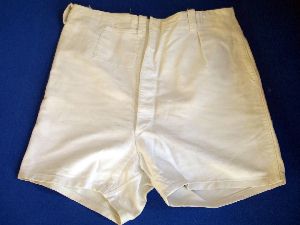 |
|
 |
|
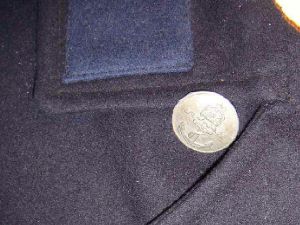 |
A pair of white shorts worn in tropical
climates, again from Robert Barsch of the SMS Iltis.
Photo © Axel Scharr |
|
An other ranks double breasted woollen winter
naval jacket ("Űberzieher" often referred
to as a "Collani" in naval slang, after the Berlin tailors Berger
& Collani who made many naval uniforms). The buttonhole bears the ribbon of an Iron Cross 2nd
Class. |
|
A close-up of the plain blue collar patch and buttons
of the double breasted jacket. |
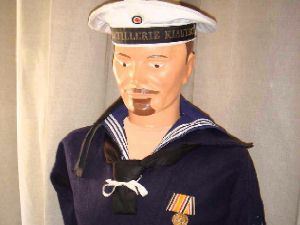 |
|
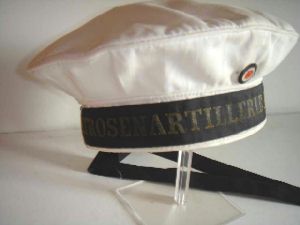 |
|
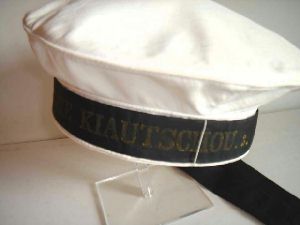 |
|
The uniform of an NCO of the 4th Artillery
Unit of the Kiautschou Naval Artillery (IV.
Artillerie Abteilung, Matrosen Artillerie Kiautschou) that manned the defences at Tsingtao. He wears a
China Campaign Medal on his left breast (issued for service in the
Boxer Rebellion 1900-01- see Medals Page
for more details) of his blue woollen winter naval top ("Wollenes
Hemd" or woollen shirt) with removable naval collar. The mixture of white summer and blue winter uniform
items was not uncommon. |
|
A close up of the white cap from the 4th Kiautschou Naval Artillery figure. |
|
A close up of other side of the white cap
from the 4th Kiautschou Naval Artillery figure. |
 |
|
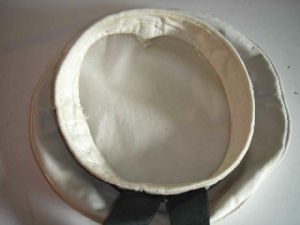 |
|
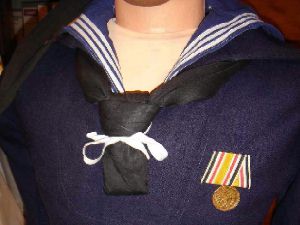 |
|
Another close up of the white cap from the
4th Kiautschou Naval Artillery figure. |
|
A close up of the inside of the white cap
from the 4th Kiautschou Naval Artillery figure. |
|
A close up of the dark blue Naval top worn with
a China
Campaign Medal from the 4th Kiautschou Naval Artillery figure. |
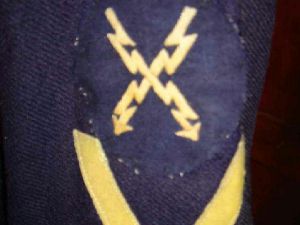 |
|
 |
|
 |
|
The specialist insignia of a telegraphist
and single rank chevron of an Obermatrose from the upper left sleeve
of the 4th Kiautschou Naval Artillery figure. |
|
A close up of the issue markings on the
inside of the uniform. They identify it as belonging to "IV MAK" (IV. Matrosen Artillerie
Kiautschou) in red wax,
with IV AA (Artillerie
Abteilung) under the name tag. The name Petersen
implies the owner was an ethnic Dane possibly from the newly added
German territories of Schleswig-Holstein. The ethnic Danes were keen
sailors and like the other newly added "Germans" from Alsace and
Lorraine formed a disproportionately high part of the naval and colonial
manpower. |
|
The rear of the of the 4th Kiautschou Naval
Artillery figure. |
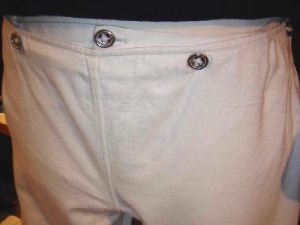 |
|
 |
|
 |
|
The white summer trousers of the of the
4th Kiaoutschou
Naval Artillery figure. |
|
A lightweight white naval working top ("Arbeitsbluse") with
necktie and a single right breast pocket |
|
The rear of the light weight white naval
top with necktie. |
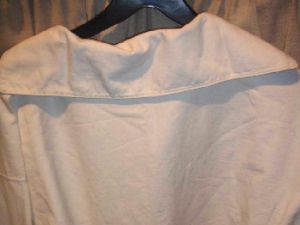 |
|
 |
|
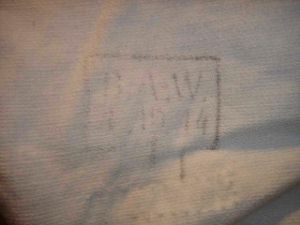 |
|
The rear of the lightweight white top with
the neck tie removed. Note that not all neck ties were removable, some
were sewn into the top. |
|
The removable neck tie from the
lightweight white top. |
|
The issue stamp inside the light weight
white top, showing it was issued in Wilhelmshaven in 1914. |
 |
|
 |
|
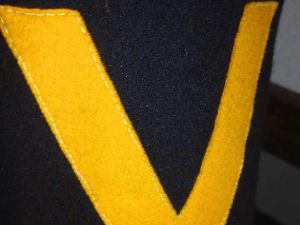 |
|
An other ranks dress jacket ("Affenjacke") from a sailor on the SMS Königsberg.
Although the jacket is dated 1913 inside this would
not have been worn in action by that date, the more practical double
breasted jacket shown above being preferred. |
|
A close up of the cuff buttons and detail
from the other ranks dress jacket. |
|
A close up of the sewn-on rank chevron
from the other ranks dress jacket showing him to be an Obermatrose. |
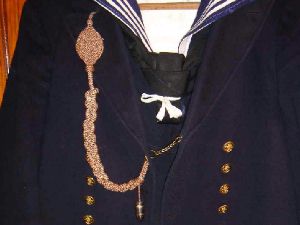 |
|
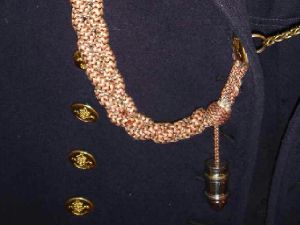 |
|
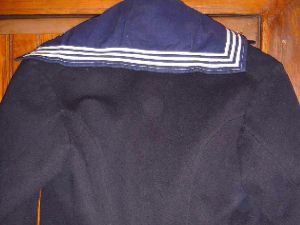 |
|
An NCO's dress jacket from one of the the Kiautschou
Naval
Artillery Batteries. It is similar to the previous other ranks jacket
but of better quality with NCO's lace. It has an artillery marksmanship award on the right shoulder in the form of silver, back and red
braid with a brass miniature of a gun shell on the end. |
|
A close up of the Artillery Shooting Award on the NCO's dress jacket. |
|
The rear of the NCO's dress jacket from
the Kiautschou Artillery Batteries. |
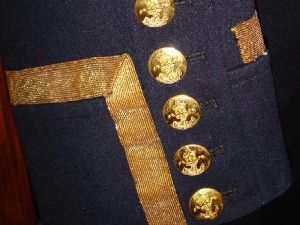 |
|
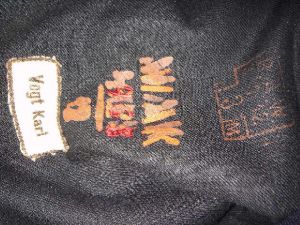 |
|
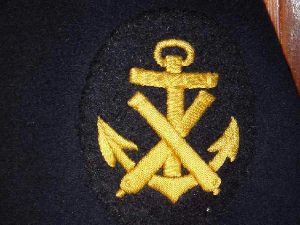 |
|
Detail of the ranking lace and buttons on
the NCO's dress jacket showing his rank to be Maat. |
|
The markings inside the NCO's dress jacket
again tell much about its history. Its unit marking is
MAK ("Matrosen
Artillerie
Kiautschou"),
the issuing office is Wilhelmshaven, dated
1912 and belonging to Maat Karl Vogt. |
|
A close up of the specialist
insignia (showing him to be a gunner) on the NCO's dress jacket from the Kiautschou
Artillery Batteries. |
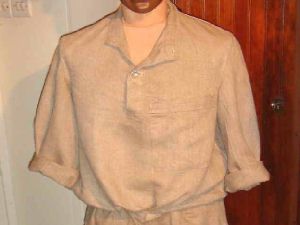 |
|
 |
|
 |
|
A rough working uniform as worn by
stockers and submariners. |
|
The issue stamp inside the working
uniform. This time from the BAK (Bekleidung
Amt Kiel). Note its very late war date suggesting it
probably never saw action. |
|
The trousers from the rough working
uniform. |
 |
|
 |
|
 |
|
An NCO's cap from the I. Werft Division.
Sailors of the Werft Divisions were used to guard naval bases
and as marine infantry on board ships. |
|
The other side of the Werft Division cap |
|
The inside of the Werft Division
cap showing the owner's name (Esser), unit number and date (1916). |
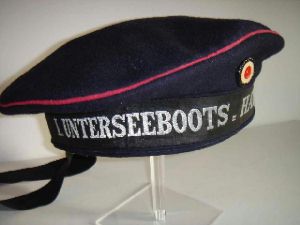 |
|
 |
|
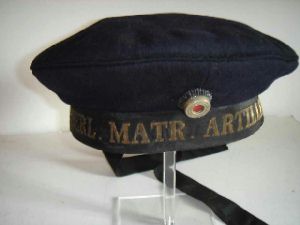 |
|
A submariner's cap. Crimson piping was
usually worn by members of torpedo boats crews.. |
|
The other side of the submariner's cap.
The full cap tally reads "1. UNTERSEEBOOTS = HALBFLOTTILLE.1.".
On board submarines the tally would have read the ship's name, while
onshore like this one it would have read like this one. |
|
An NCO's cap from the Imperial Naval
Artillery. The cap tally reads "KAISERL. MATR. ARTILLERIE" |
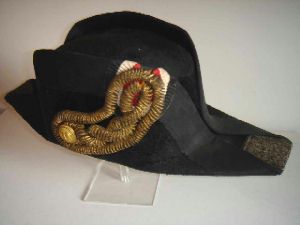 |
|
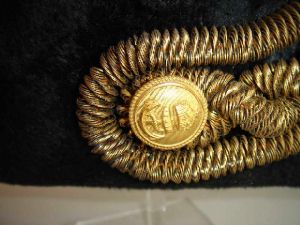 |
|
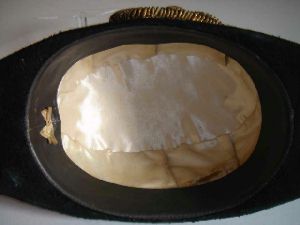 |
|
A naval officer's cocked bicorn hat. Worn for
dress and parade duties, these hats were not worn in action. |
|
A closer look cord and brass button. |
|
A look inside the officer's cocked hat. |
 |
|
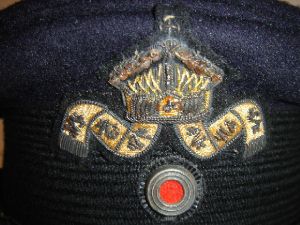 |
|
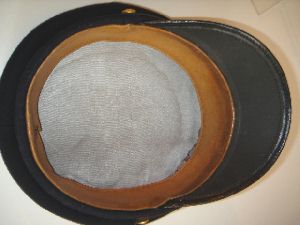 |
|
A Deck Officer's blue cap. The cap has a
black hatband with imperial cockade and a black leather chinstrap
and peak. The insignia for junior or deck officer was an imperial
crown embroidered in gold. |
|
A close up of the deck officer's insignia
and imperial cockade. |
|
A view of the inside of the deck officer's
hat. Being of private purchase it has no issue stamp. |
 |
|
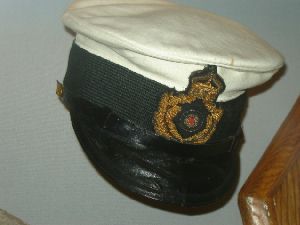 |
|
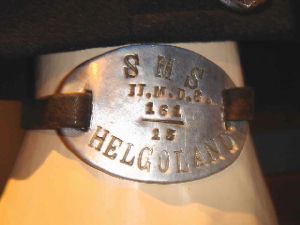 |
|
A close up side view of the deck officer's
blue hat showing the brass button holding the chin strap. Note the
naval anchor and imperial crown on the button. |
|
A German naval officers white summer
cap. Note the senior officers' insignia of an embroidered imperial
crown with a wreath around the imperial cockade.
(Imperial War Museum Collection) |
|
An identification tag worn by Imperial
German sailors. The markings identify the original owner as belonging to the SMS Helgoland, II MD is the 2nd Matrosen Division. The 13
refers to the year 1913. |
|
|
|
 |
|
|
|
|
|
A cap tally from the SMS Tiger which
served in China. |
|
|
|
|
|
|
|
|